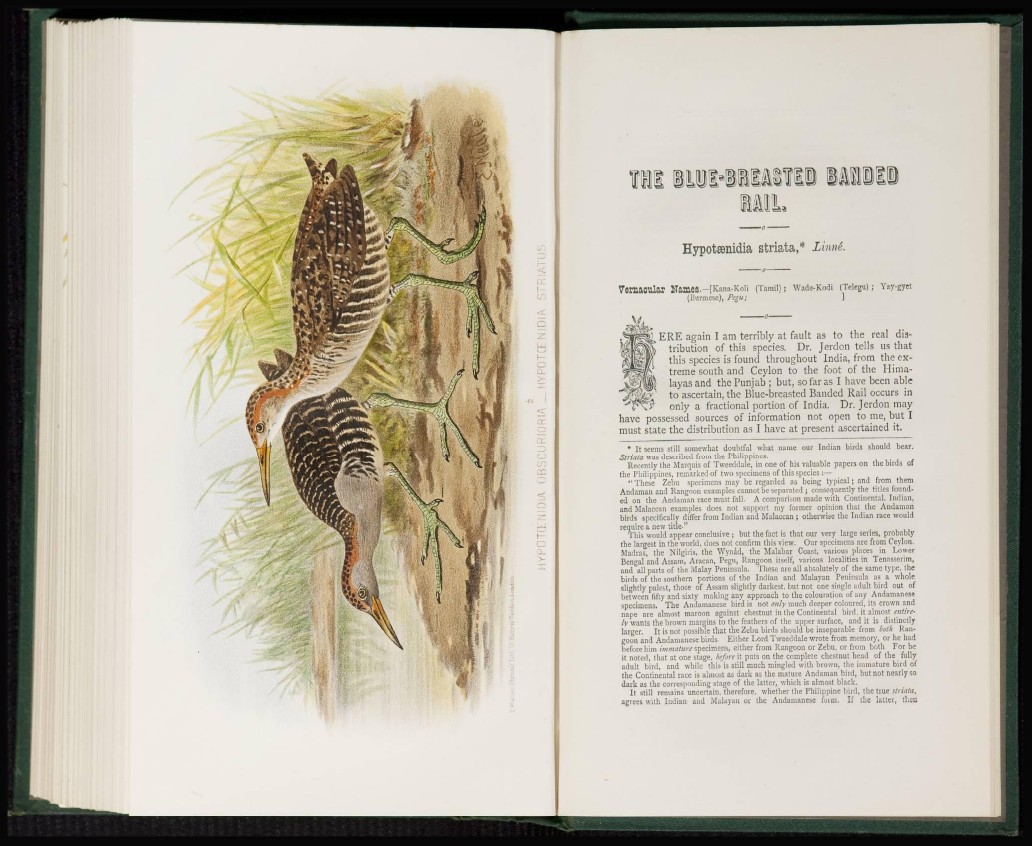
ML
Hypoteenidia striata,* LinnS,
Vernacular Names-— [Kana-Koli (Tamil) ; YVade-Kodi (Telegu) ; Yay-gyet
(Burmese), Pegu; ]
ERE again I am terribly at fault as to the real distribution
of this species. Dr. Jerdon tells us that
this species is found throughout India, from the extreme
south and Ceylon to the foot of the Himalayas
and the Punjab ; but, so far as I have been able
to ascertain, the Blue-breasted Banded Rail occurs in
only a fractional portion of India. Dr. Jerdon may
have possessed sources of information not open to me, but I
must state the distribution as I have at present ascertained it.
* It seems still somewhat doubtful what name our Indian birds should bear.
Striata was described from the Philippines.
Recently the Marquis of Tweeddale, in one of his valuable papers on the birds of
the Philippines, remarked of two specimens of this species :—
" These Zebu specimens may be regarded as being typical ; and from them
Andaman and Rangoon examples cannot be separated ; consequently the titles founded
on the Andaman race must fall. A comparison made with Continental. Indian,
and Malaccan examples docs not support my former opinion that the Andaman
birds specifically differ from Indian and Malaccan ; otherwise the Indian race would
require a new title."
This would appear conclusive ; but the fact is that our very large series, probably
the largest in the world, does not confirm this view. Our specimens are from Ceylon.
Madras, the Nilgiiis. the Wynad, the Malabar Coast, various places in Lower
Bengal and Assam, Aracan, Pegu, Rangoon itself, various localities in Tcnasserim,
and all parts of the Malay Peninsula. These are all absolutely of the same type, the
birds of the southern portions of the Indian and Malayan Peninsula as a whole
slightly palest, those of Assam slightly darkest, but not one single adult bird out of
between fifty and sixty making any approach to the colouration of any Andamanese
specimens. The Andamanese bird is not only much deeper coloured, its crown and
nape are almost maroon against chestnut in the Continental bird, it almost entirety
wants the brown margins to the feathers of the upper surface, and it is distinctly
larger. It is not possible that the Zebu birds should be inseparable from both Rangoon
and Andamanese birds Either Lord Tweeddale wrote from memory, or he had
before him immature specimens, either from Rangoon or Zebu, or from both For be
it noted, that at one stage, before it puts on the complete chestnut head of the fully
adult bird, and while this is still much mingled with brown, the immature bird of
the Continental race is almost as dark as the mature Andaman bird, but not nearly so
dark as the corresponding stage of the latter, which is almost black.
It still remains uncertain, therefore, whether the Philippine bird, the true striata,
agrees with Indian and Malayan or the Andamanese form. If the latter, then